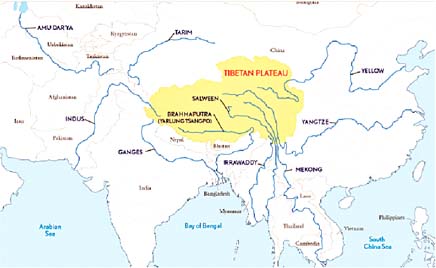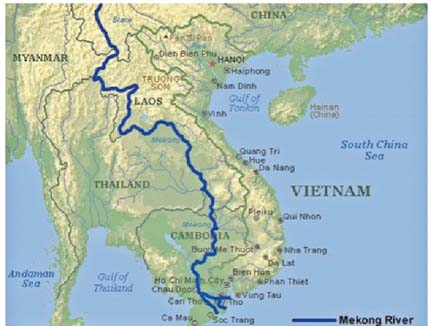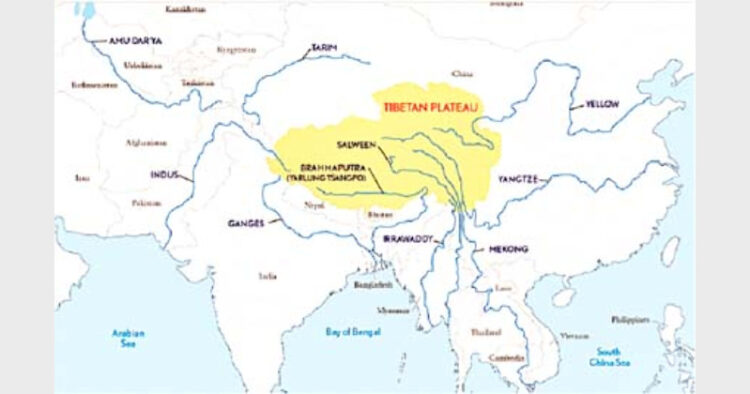Water is the ‘next oil’. And future wars will be fought over it. Surprisingly, Communist China is already deep into it, by playing ‘water politics’
-TS Chandrashekar

China wishes to control upstream rivers in order to
cause water scarcity in downstream countries whenever it wants
cause water scarcity in downstream countries whenever it wants
Water is a strategic natural resource, and scarcity of water has been a cause of political conflicts throughout the world. With decreasing availability and soaring demand for water, some have predicted that water will become the “next oil.” Mollinga, PP classifies water politics into four categories, “the everyday politics of water resources management”, “the politics of water policy in the context of sovereign states”, “inter-state hydropolitics” and “the global politics of water.”
As a study by Madeleine Lovelle, Research Analyst, Global Food and Water Crises Research Programme, 46 per cent of the world’s population depends on rivers originating from Tibet, including the Indus, Ganges, Brahmaputra, Irrawaddy, Salween and Mekong rivers. With China, India, Nepal, Bhutan, Bangladesh, Pakistan, Vietnam, Myanmar, Cambodia, Laos, and Thailand all dependent on the rivers, water shortages will threaten the livelihoods of millions of people living in countries downstream.
Mao Zedong annexed Tibet in 1950 largely for its strategic position and water resources. Most of China is arid and water is regarded as an important issue. Building dams, irrigation systems and diversion projects are considered vital not only for providing water to its 1.3 billion population but also for ensuring internal political stability. Any threat to China’s control of Tibet and its water could alter the distribution of power between China and the countries downstream.
All its neighbours have accused China of playing water politics war. China wants to control the upstream rivers by re-engineering trans-boundary flows through dams and other structures. Its dam building has mostly shifted from internal rivers to transnational rivers, such as the Mekong, Salween, Brahmaputra, Irtysh, Illy and Amur. Its actions in recent years have sought to build water leverage over its downstream neighbours. By 2018 itself China had 86,000 dams, which on an average, come to at least one dam per day since 1949. Nearly a third of these are large dams having a height of at least 15 metres (49 feet) with a water storage capacity of more than 3 million cubic metres (793 million gallons).
Eyes on Earth, a research and consulting firm on water, recently found that China is holding back large amount of water upstream on the Mekong River, causing drought in the South East Asian countries downstream last year. The Mekong River which is 4,350 kilometres long runs through six countries. Called the Lancang River in China, it flows past countries like Cambodia, Laos, Thailand and Myanmar, before emptying into the South China Sea via Vietnam. At the centre of the changing face of the Mekong is China’s master plan to open a passage for massive cargo, said Fitch Solutions. That passage from the Yunnan province through the Mekong countries and into the South China Sea may potentially include military ships in the future, the research house added.
China’s activities along the Mekong River have long been contentious. A recent study has sparked fresh scrutiny re-igniting warnings that millions of livelihoods could be destroyed. Chinese dams upstream on the Mekong had caused drought last year in the South-east Asian countries.
The Mekong is the lifeline of nearly 200 million people who depend on farming and fishing for their livelihood. China built its first dam on the Upper Mekong in the 1990s and currently has 11 dams along the river. The country plans to build more dams to generate hydropower. Some of those dams have compounded the river’s natural flow, resulting in the Lower Mekong recording “some of its lowest river levels ever throughout most of the year.”
Using data from 1992 to 2019, and satellite measurements of “surface wetness” in China’s Yunnan province a report by the UN-backed Sustainable Infrastructure Partnership and the Lower Mekong Initiative suggest the region had slightly above-average combined rainfall and snowmelt from May to October 2019. But water levels measured downstream along the Thai-Lao border were at times lower than they should have been, according to Alan Bassist and Claude Williams, who authored the report. This points to China holding back dam waters while lower Mekong countries experienced a drought that impacted rice production and fisheries, threatening food security for the region.
“China’s dam management is causing devastating changes in water levels downstream,” according to Washington-based security think tank, Stimson Center. Beijing considers water as a sovereign commodity for consumption rather than as a shared resource. Researchers at Stimson Center offered one reason why China might be holding back the water resources. “Beijing treats information about water flow and hydropower operations as a “state secret.” This lack of transparency allowed China to set a narrative of shared suffering due to the drought and established a common cause for China to deepen its economic cooperation with the downstream through its Lancang-Mekong Cooperation Mechanism.”

China’s Hydropolitics has caused droughts in several
South-East Asian countries last year
South-East Asian countries last year
At last, one can say that China is a threat to all of its neighbours. Now China is weaponising the sharing of water data on upstream river flows, for instance in 2017, in violation of two legally-binding bilateral accords. China refused hydrological data to India, for boycotting China’s “Belt and Road Initiative” and border stand-off on the remote Himalayan plateau of Doklam. The Brahmaputra River in 2017 caused record flooding that left a significant trail of death and destruction, especially in India’s Assam state. Some of these deaths might have been prevented had China’s data been available to India’s flood early-warning systems.
In the same way with Territorial and Water Disputes with South East Asia Nations China is controlling water and causing wilful drought by controlling the water flow. It does not listen to any world body or agency and uses every action of it as its right. Meanwhile, Bharat, which believes in Vasudhaiva Kutumbakam, respects water as god than as a political weapon. China should not impose its rules and regulations on her neighbours.
(The writer is a Political Analyst, Columnist, International Affairs and Korea Expert)













Comments